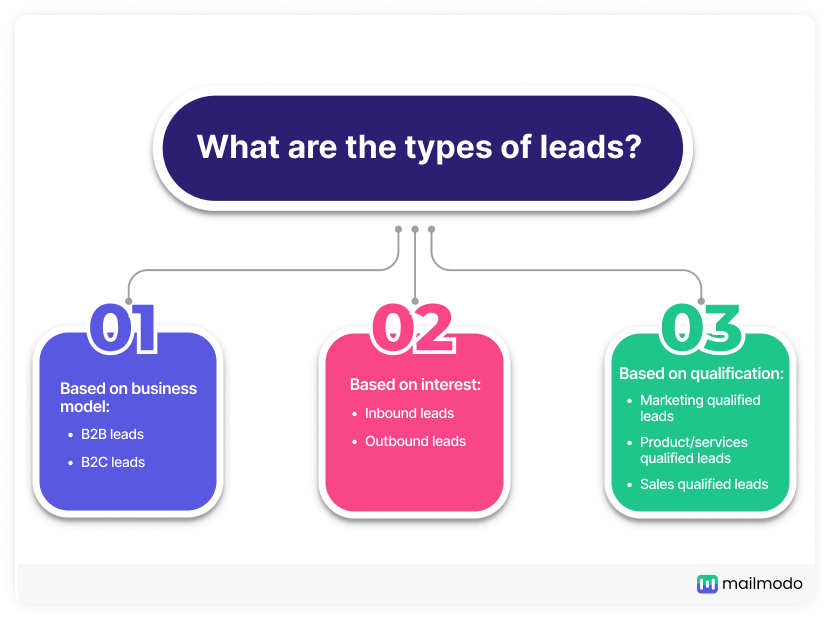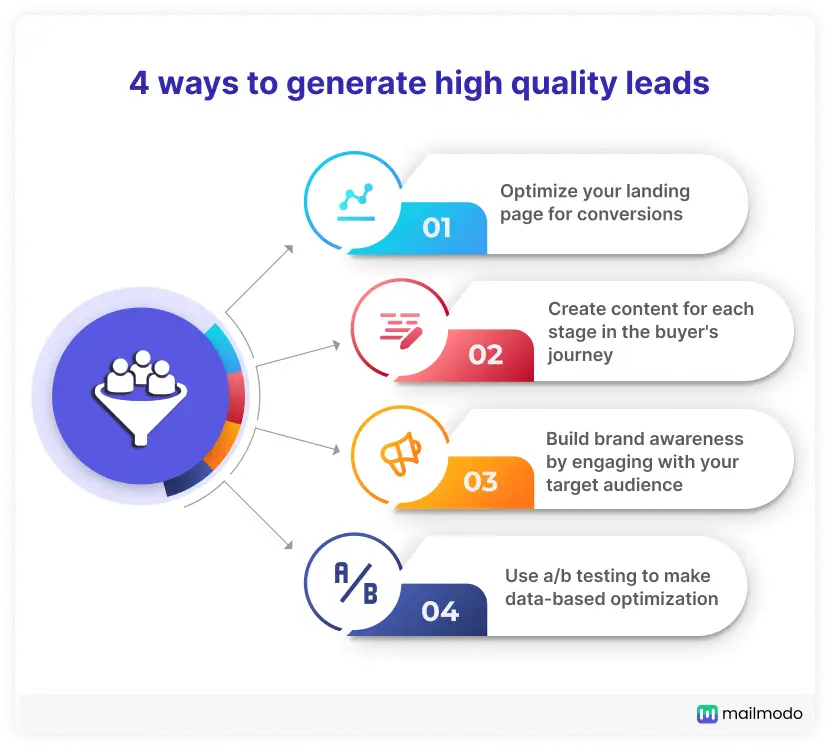Every business owner strives to generate leads, nurture them into paying customers and boost the company's revenue.
But, finding leads is often a pressing task. Without effective lead generation strategies, the sales, and marketing team is often lost.
So, to put you out of your dilemma, we have created this lead generation guide. We will cover types of leads, the lead generation process, and tactics to generate leads.
Table of contents
What is a lead?
A lead is an individual or business interested in your product/services. Anyone who shares their information, whether via email signup or webinar registration can become a lead.
Leads can enter at any stage in a consumer lifecycle through different channels, like social media, organic search, or paid ad campaigns. Even the lead quality varies as not every lead will enter through the same channel and show the same interest in your product/services. Thus, for different leads, you need to have different strategies to engage, nurture, and convert them.
What are the types of leads?

Leads can be qualified based on their interest and qualification. Let's discuss each of them in detail:
Based on the business model:
B2B leads
B2B stands for business to business, a company that sells to other companies. So, in B2B, a lead can be a company or its employees.
The time to generate leads in B2B is often longer as the decision-making process involves approval and evaluation from different people. Hence, in B2B, the lead is not only an individual but also the entire organization.
Related guide: B2B Lead Generation: 11 Strategies to Capture High-Quality Leads
B2C leads
B2C stands for business to consumer, a company that sells directly to the individual. The B2C leads are captured instantly as there is a single party who makes the final decision.
Based on interest:
Inbound leads
Inbound leads are prospects who show interest in your brand by themselves. They might interact with your social media posts or fill out the lead gen form, etc.
Outbound leads
These leads come to know your brand when your team reaches out to them. You can reach out via cold emailing, Linkedin, or running targeted paid ad campaigns.
Based on qualifications:
Marketing qualified leads
Marketing qualified leads (MQLs) interact with your marketing efforts, newsletter signup, webinars, checklist download, etc.
These leads are in the early stages of their buyer's journey and are not yet ready to be qualified as sales leads.
Product/services qualified leads
Product or service qualified leads are individuals who have tried your product/services via a free trial. These leads exist only for the brand that offers a free trial to the users. These leads are superior to the MQLs as they have tried your product/service firsthand.
Sales qualified leads
Sales qualified leads (SQLs) show interest in getting more information about your product/services. For example, someone getting on a call with your customer support team.
Now that we have covered the types of leads, let's discuss the lead generation process.
What is lead generation?
Lead generation is the process of finding people who might be interested in your product or services through inbound and outbound marketing. Once you get the leads, you qualify them by assigning them a lead score.
Lead generation involves:
identifying the target prospect
understanding their lifecycle stage
implementing different tactics to attract, engage, and convert them into leads.
Why is lead generation important?
Lead generation is crucial to keep your business afloat. Through a well-crafted lead generation strategy, you can identify high-quality leads from your target audience, and engage with them to nurture them into customers. Such continuous lead acquisition will help increase the revenue and let businesses thrive.
A lead generation strategy is also effective in identifying people interested in your product/services but aren't ready to use it right away. In such cases, you can always keep engaging with them and build strong relationships. So, when they're ready to buy, your company will be the first in their minds.
Related guide: How to Create a Successful Customer Acquisition Strategy to Grow Your Business
Lead generation process
As we discussed earlier, there are two ways you can acquire leads - inbound and outbound. Both of them follow a different lead generation process which is discussed below:
The inbound lead generation process
Inbound lead generation is about attracting, educating, and compelling people to take action. The prospect can find out about your business through social media, organic search, referrals, etc.
You can use blog posts, lead magnets, case studies, or templates, to build brand awareness. If your audience finds your content valuable, they might take action and become a lead.
On a general level, this is what the inbound lead generation process looks like:
First, a visitor finds your website through different marketing channels such as organic search, social media posts, referrals, etc.
The visitors interact and engage with your website. If your content resonates with them, they will click on the CTA - email signup, ebook download, checklists download, etc.
They are redirected to fill out a form asking for their basic information - Name, email address, contact number, etc.
Voila! You've got a new inbound lead.
The outbound lead generation process
Your sales team reaches out to interested prospects via cold email or Linkedin in outbound lead generation. Your sales team keeps the conversation going by sharing informative content and case studies and trying to build trust among the prospects.
In outbound lead generation, interested prospects are often asked to get on a demo call with the sales team.
Everyone who takes action (signup, ebook download, etc.) will be keen on trying your product/services. Spending time, energy, and money nurturing every lead can be fruitless. Thus, you need to manage your leads, and one way to do that is via lead scoring.
What is lead scoring?
Lead scoring is grading leads that you capture by giving scores or points based on their attributes. These attributes can be:
Professional: Position in the company, size of the company
Demographic: Age, gender, ethnicity
Behavioral: Page they visited the most, the content they interacted with, etc.
Based on these attributes, each lead is assigned a score that helps the sales team prioritize, leading to nurturing and increasing their chances of conversions.
For instance, you can give a higher score to a lead if they regularly interact with your emails and social media posts. The higher the lead score, the closer they'll be to qualifying as sales or product-qualified leads from MQL.
How to generate leads for your business
Here we will discuss how you can use different channels to capture high-quality leads for your business:
Email lead generation
Email is the best way to lead generation, with 53% of marketers citing it as the most effective channel for early-stage lead generation. Commonly, emails are used to cold outreach to interested prospects and pitch your product/services.
You can also run email ads either in the target prospects' inboxes or through sponsorship. The benefit of lateral tactics is you can get access to other brands' loyal audiences and showcase your offer.
Learn different email lead gen tactics in detail in our guide - How to Generate Leads Through Email Marketing in 2022.
Facebook lead generation
Undoubtedly, Facebook has evolved into an effective marketing channel and has a 2.8 billion user database. This is one of the many reasons why it's the most used social media channel by marketers.
Besides, Facebook offers many tactics for B2B and B2C lead generation like Facebook lead gen forms, live video chats, boosted organic posts, etc.
Each tactic helps marketers get more eyeballs, increasing lead generation numbers.
Want to know more? Check out our 11 Facebook Lead Generation Tactics to Capture High-Quality Leads.
Linkedin lead generation
Linkedin is the hub of businesses and professionals. You can connect with your prospects - Managers, VP, marketers, sales executives, etc., and start a conversation with them. Try to build a strong connection with them, understand their pain points, and pitch your offer at the right time.
Linkedin also offers ads and lead gen forms you can use to generate leads for your business. Additionally, you can get emails from Linkedin for cold outreach through different tools.
Learn the basics of using Linkedin for B2B lead generation.
PPC SERP ads
Google is the dominating search engine with a market share of 92.07% in April 2022, making it a prime real estate to run pay-per-click ad campaigns to get high-quality leads.
But, for an effective ad campaign, you need to target the right keyword and analyze your ad budget and market share of 92.07% as of April 2022goals. Besides, the ad copy also plays a significant role in getting clicks and engagement on your ad campaigns. We cover the PPC ad campaign in detail in our guide.
Check it out: How to Create a Pay per Click (PPC) Advertising Campaign.
Tips for generating high-quality leads

To get the high-quality leads, here are some tips you should follow:
1. Optimize your landing page for conversions
No matter which channel or tactic you use, chances are you will redirect people to your landing page. So, it is the job of your landing page to hook the reader, showcase the value, and push them towards that CTA button.
Above the foil should work as a hook to grab the visitor's attention, give them an overview of your offer, and build credibility via social proof. Below the fold should help them give a brief about how your product can solve their pain points.
Our landing page optimization guide covers these elements and best practices in-depth. Do check it out.
2. Create content for each stage in the buyer's journey
The mindset and level of awareness visitors have at each funnel stage varies as they upgrade from one stage to the next. So, the content that resonates with visitors in the awareness stage will not work for someone in the consideration stage.
To capture high-quality leads, you need to map the visitor's journey and create content and offer it to the visitors at the right stage.
Fishing it difficult to map your visitor's journey? Checkout out our guide - How to Build Customer Journey Maps for Your Buyer Personas.
3. Build brand awareness by engaging with your target audience
Your marketing and sales team must reach out to your audience where they hang out the most - Linkedin, Instagram, Twitter, or any other social channel. The more you engage with your audience the more you can get them familiar with your product/services. Hence, improving brand awareness.
4. Use a/b testing to make data-based optimization
Don't rely on guesswork, as you might lose your money and the audience's trust. Instead, focus on data collected via A/B testing and draw insights to optimize the customer experience. A/B testing your website's paid ad campaigns, email subject lines, etc., which can help you analyze which version users prefer most and drive higher clicks and engagement. Based on this statistically significant data, you can make better optimization decisions.
Lead generation tools
Lead generation isn't a linear process. It consists of different tactics and channels and thus requires various tools to optimize each step to get high-quality B2B, and B2C leads for your business.
We have curated a list of the best lead generation tools for different steps:
| Steps | Tool name |
|---|---|
| Email finder tools | Hunter |
| Snov.io | |
| Apollo | |
| Communication tool | Intercom |
| Drift | |
| CRM | Hubspot |
| Pipedrive | |
| Email service providers | Mailmodo |
| Litmus | |
| Marketing automation tools | Pardot |
| Omnisend |
Way forward
Lead generation might seem daunting, but it's crucial to build a strong customer database and ensure business sustainability. With the information covered in this guide, you can begin generating leads for your business.
Once you get the leads, your next step should engage with them and nurture them. One of the best channels to nurture leads is via emails. Email offers direct communication and is used by billions of people around the globe. So, pick the right email marketing campaign and start nurturing those leads into paying customers.
What you should do next
Hey there, thanks for reading till the end. Here are 3 ways we can help you grow your business:
Talk to an email expert. Need someone to take your email marketing to the next level? Mailmodo’s experts are here for you. Schedule a 30-minute email consultation. Don’t worry, it’s on the house. Book a meet here.
Send emails that bring higher conversions. Mailmodo is an ESP that helps you to create and send app-like interactive emails with forms, carts, calendars, games, and other widgets for higher conversions. Get started for free.
Get smarter with our email resources. Explore all our knowledge base here and learn about email marketing, marketing strategies, best practices, growth hacks, case studies, templates, and more. Access guides here.


